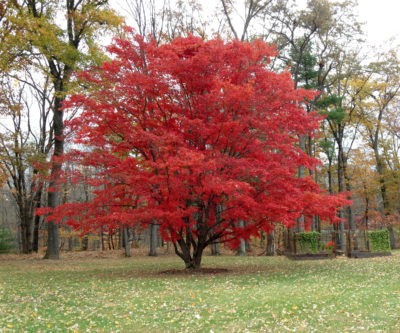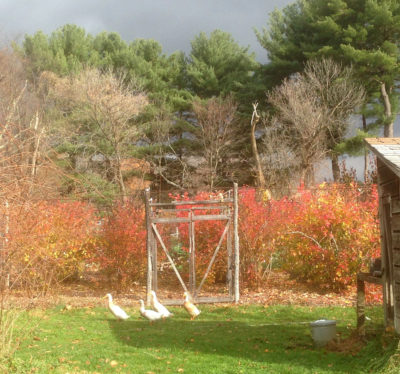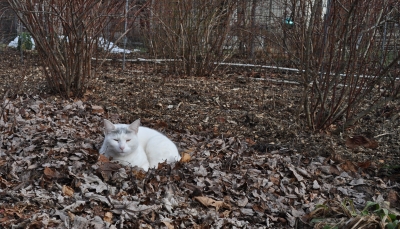Just Like Korea?
The bone dry weather blanketing the Hudson Valley and much of northeastern U.S. does have its saving graces. For one thing, it forces perennial plants to shut down and direct their energies to toughening up for cold weather lurking over the horizon. That’s a good thing — unless, of course, the soil gets dry enough to kill a plant. Deciduous plants have the option, before that happens, to drop their leaves, drastically reducing their water loss and needs.
This dry autumn weather is not unlike that in many parts of Korea. So what? When it comes to cold-hardiness, some plants that survive Korea’s frigid winters typically are done in by our similarly frigid winters. One plant that comes to mind is Asian persimmon (Diospyros kaki). The chances of an Asian persimmon surviving a winter here at my Zone 5 farmden and ripening its fruits are generally not good. Autumn weather like this year’s ups the odds.

Asian & American persimmon, compared
(American persimmons (D. virginiana), on the other hand, easily survive, and varieties such as Szukis and Mohler reliably ripen their fruits here.)
Survival of an Asian persimmon here is very topical to me because I planted one this past spring. I did plant one of the most cold-hardy varieties, Great Wall. This variety is allegedly hardy and will ripen fruit in Zone 5 (at least that’s what Lee Reich wrote in the book Uncommon Fruits for every Garden). This autumn weather should help get it through its first winter here.
Autumn Color Chemistry
This bone dry weather has also made for glorious autumn leaf colors, even more than usual. Did I write, last year, that autumn color was the best ever, and the year before that, and . . . ? The reason for the exquisite color is physiological (the leaves’, not mine).
Leaves can, of course, be green. Other colors also figure in, obscured by the green of chlorophyll until autumn’s cooler weather and shorter days dissolve away the chlorophyll to let these other colors strut their stuff. Autumn’s fiery oranges and yellows, especially prominent in sugar maple, gingko, aspen, hickory, and beech, are from carotenoids. Tannins are another color component that get expressed in autumn; they give oaks their brown color, and enrich the yellow hues of beeches and hickories.

Japanese maple in autumn
Unless an early freeze burns off trees’ leaves while they are still green, those oranges and yellows and browns put on a reliable show every autumn, no matter what the weather.
Not so for the reds and purples of autumn leaves. These colors are expressed by anthocyanins, compounds which are not present or obscured by the green of chlorophyll during the growing season. Anthocyanins develop in autumn, and they need sugars for their development. Sugars come from photosynthesis, whose driving energy is sunlight.
So, less rain and more sunny weather means more photosynthesis, more sugars, and better red and purple color in such plants as blueberry, sourwood, scarlet oak, and sugar maple. A recent spate of warm days and cool nights enhances the whole effect, the warm days spurring photosynthesis and the cool nights slowing respiration to slow “burning” of sugars.
But How About Some Rain?
Much as I revel in day after day of clear, sunny weather and trees alive in color, I’d like a few heavy rains. The water supply of many homes on my road tap into shallow groundwater, the level of which is very low at this point.
Also, my drip irrigation system has been disconnected. The timer, the pressure reducer, and the filter, all of which must greet water as it comes out the spigot, before it enters the main lines, have been brought indoors to be protected from the recent freezing temperatures.
With reduced transpiration from cooler weather, autumn’s usual rainfalls can carry winter radishes, endive, Chinese cabbage, and other cool weather vegetables on a few more weeks until the end of the season. But we need these usual rains.






